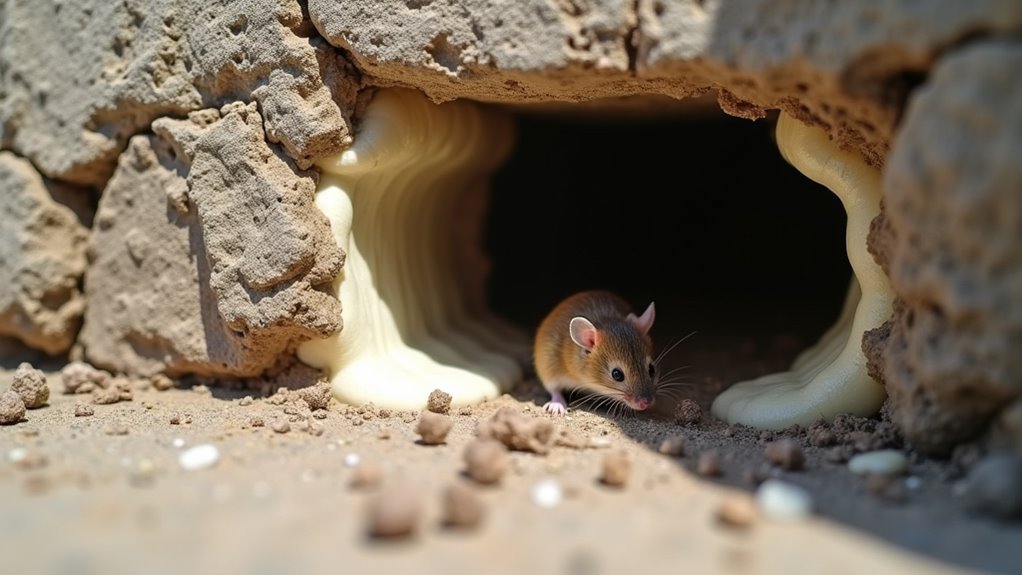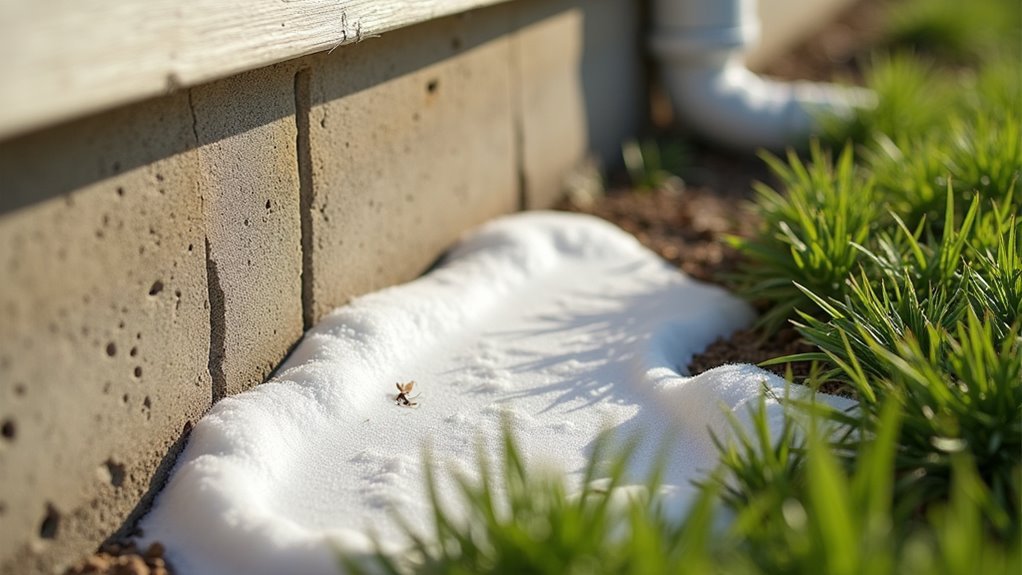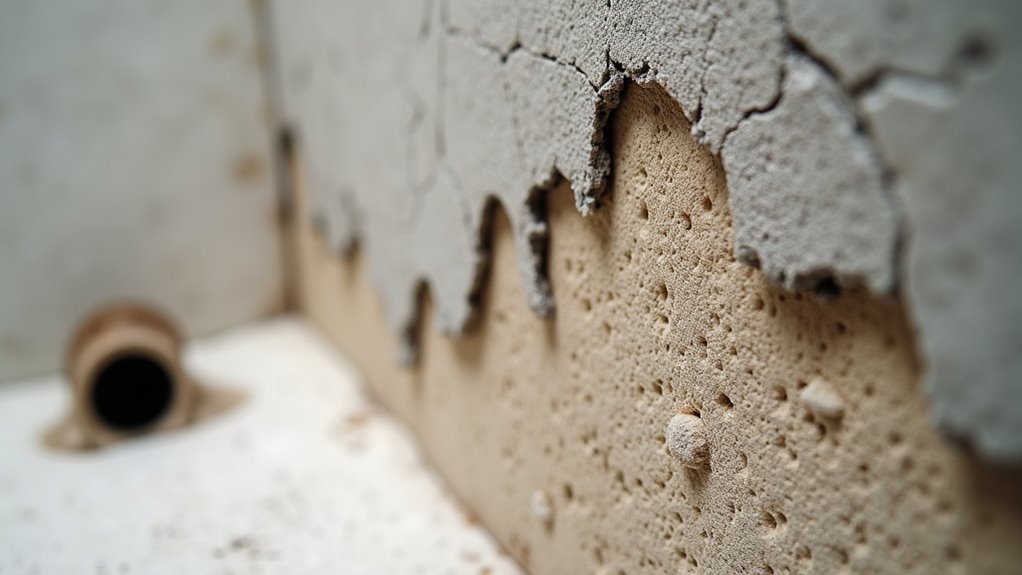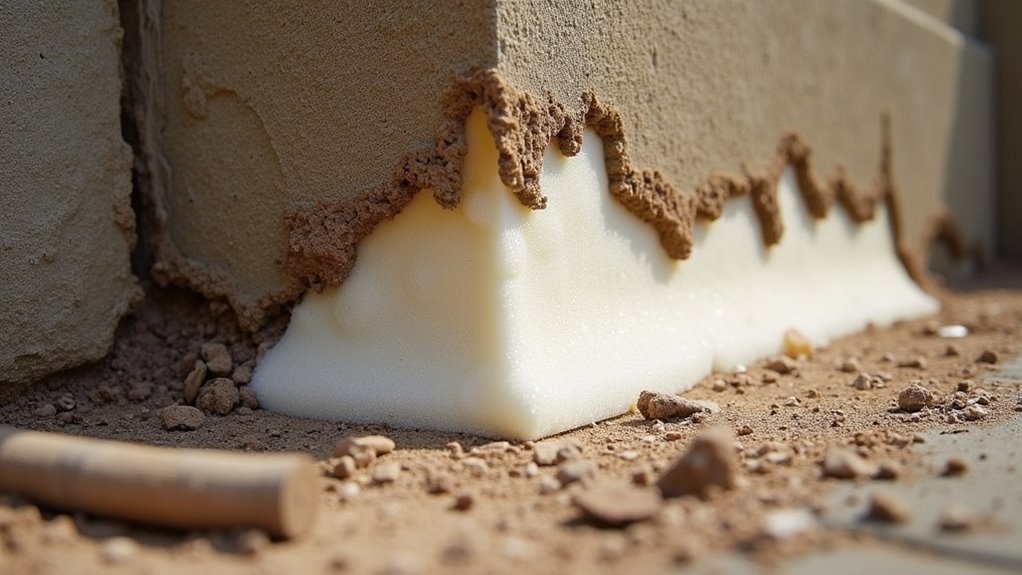Expanding foam fails for foundation mouse-proofing because its porous structure creates interconnected air pathways that allow odors and pressure changes to escape, fundamentally creating a highway system that guides mice to entry points. You can seal every visible crack, but mice use their keen sense of smell to detect openings behind the foam, then easily chew through this soft material to reach your foundation. Understanding the science behind these failures reveals why professional alternatives prove far more effective.
Understanding Foundation Vulnerabilities to Mouse Intrusion

Foundation vulnerabilities create perfect highways for unwanted rodent visitors. Your home’s foundation contains numerous gaps and cracks that mice exploit as entry points, especially where pipes and cables penetrate the structure.
These persistent invaders can squeeze through openings as small as a dime, making even tiny foundation flaws potential access routes.
Moisture and deteriorating materials in your foundation act like magnets, attracting mice seeking shelter and warmth. Poor maintenance compounds the problem as settling creates larger gaps over time.
Foundation moisture and poor upkeep create an open invitation for mice, with structural settling expanding entry points over time.
Mice use their exceptional sense of smell to locate hidden entry points you might miss during inspection.
Without proper sealing, your foundation becomes a welcome mat for rodent intrusion, regardless of other pest control measures you’ve implemented.
The Science Behind Expanding Foam’s Open Cell Structure
When you examine expanding foam under a microscope, you’ll discover it’s comprised of countless interconnected bubbles that create pathways throughout the material.
This network structure allows air to flow freely through the foam, undermining its effectiveness as a rodent barrier.
You’re fundamentally creating a porous material that transmits odors and air pressure changes, both of which can alert mice to potential entry points.
Interconnected Bubble Network Structure
Microscopic examination of expanding foam reveals a complex network of interconnected air pockets that fundamentally undermines its effectiveness as a rodent barrier.
You’re practically creating a highway system that allows air, odors, and vapor to flow freely through the material. When mice encounter these foam-sealed areas, they’ll detect the telltale signs of openings behind the barrier.
This interconnected structure creates four critical vulnerabilities:
- Air currents carry your home’s scent directly to waiting rodents
- Pressure changes telegraph the presence of accessible spaces
- Odor molecules freely penetrate the porous foam matrix
- Mice would easily chew through the weakened cellular framework
The expanding foam’s bubble network practically broadcasts an invitation rather than creating an impenetrable seal to prevent mice from entering your foundation.
Air Flow Permeability Issues
The open cell structure of expanding foam creates a breathable membrane that betrays your sealing efforts at the molecular level.
Air molecules move freely through the interconnected bubble network, creating pathways that allow odors and pressure changes to escape through what appears to be a solid barrier.
This permeability transforms your foam seal into a detection system for mice. When air flows through the porous material, it carries scent molecules that alert rodents to potential entry points.
Your expanding foam fundamentally becomes a beacon, advertising the location of holes rather than sealing them. The continuous air movement prevents the creation of a true barrier, allowing mice to sense what’s behind the foam and encouraging them to investigate further through chewing and clawing.
Odor Transmission Through Foam
Although expanding foam appears solid from the outside, its internal architecture functions like a molecular highway system that broadcasts your home’s interior scents directly to passing rodents.
The interconnected bubble network creates pathways that allow air pressure and odors to flow freely through the material.
Your expanding foam fundamentally becomes a scent beacon because:
- Pet food aromas travel through foam’s open cells, advertising your kitchen’s location
- Cooking smells permeate the material, creating an irresistible dinner invitation
- Warm air currents carry your home’s odors through interconnected bubbles
- Broken foam sections amplify odor transmission, turning small gaps into scent highways
Mice depend on their exceptional sense of smell to locate entry points.
When foam compromises, it greatly increases odor transmission, fundamentally guiding rodents straight to your foundation’s weakest spots.
How Mice Navigate Using Sensory Detection Methods
When you’re dealing with mice infiltrating your foundation, understanding their remarkable sensory capabilities becomes essential for effective prevention. You’re not just facing random rodents—you’re confronting creatures equipped with sophisticated detection systems that make foam barriers inadequate.
| Sense | Detection Capability | Impact on Foam Barriers |
|---|---|---|
| Smell | Locates holes and entry points | Detects gaps behind foam |
| Touch | Navigates through tight spaces | Identifies foam texture differences |
| Hearing | Senses vibrations and threats | Detects hollow spaces in foam |
| Whiskers | Gauges opening sizes | Measures foam thickness |
| Combined Senses | Locates food, nests, escape routes | Bypasses traditional sealing methods |
These combined sensory abilities allow mice to efficiently locate vulnerabilities in your foundation that expanding foam simply can’t address thoroughly.
Why Air Permeability Compromises Foam Effectiveness

Despite its initial appearance as a solid barrier, expanding foam’s open-cell structure creates microscopic pathways that mice can exploit through their acute sensory abilities.
When you examine broken foam, you’ll discover interconnected air bubbles that allow airflow throughout the material. This air permeability becomes your worst enemy in rodent control.
Here’s why air-permeable foam fails you:
- Scent highways – Odors from your home travel through foam, creating aromatic trails that guide mice directly to entry points.
- Air current detection – Mice feel subtle air movements through foam, pinpointing exact breach locations.
- Compromised sealing – Air gaps mean the foam never truly blocks access routes.
- False security – You think you’ve sealed holes while actually creating mouse-detectable pathways.
This permeability explains why regulatory standards prohibit foam for pest control applications.
Chewing Behavior and Material Selection in Rodents
You’ll find that rodents make strategic decisions about what to chew based primarily on what their noses tell them about potential entry points and material composition.
They’re naturally programmed to conserve energy, so they’ll target softer materials that require less effort to penetrate rather than wasting energy on harder substances.
When mice detect air currents or scents flowing through expanding foam, their acute sense of smell guides them directly to these compromised areas where they can easily chew through to access the gaps beneath.
Sensory-Driven Chewing Decisions
Mice don’t chew randomly through your foundation materials—they’re strategic hunters guided by their exceptional sense of smell. When they detect specific sensory cues, they’ll invest energy in chewing through barriers that would otherwise remain untouched.
Your expanding foam becomes a target when it provides these compelling signals:
- Air currents flowing through gaps signal accessible pathways to shelter
- Food odors from inside your home create irresistible motivation to breach barriers
- Moisture scents indicate potential water sources worth the chewing effort
- Structural weakness markers like soft textures or hollow sounds trigger investigation
Without these sensory triggers, mice conserve energy and move elsewhere.
However, expanding foam’s porous nature often traps air currents and odors, creating exactly the wrong signals that attract determined chewing behavior.
Energy Conservation Motivates Selectivity
When rodents encounter potential barriers around your foundation, they’re running constant cost-benefit calculations that determine whether chewing is worth their metabolic investment.
Your mice won’t waste precious energy gnawing through materials randomly—they’re selective creatures that prioritize efficiency. They’ll only commit to chewing when their sensitive noses detect promising scents or air currents indicating an accessible entry point beyond the barrier.
This energy-conservation instinct works in your favor when you understand it properly. Expanding foam often fails because it doesn’t completely eliminate the sensory cues that signal “opportunity” to rodents.
When mice smell food sources or detect airflow through inadequately sealed gaps, they’ll invest the energy to chew through foam. However, when barriers effectively mask these detection triggers, mice typically move on to easier targets.
Detection Through Smell
How do rodents pinpoint the exact locations where they should invest their chewing energy? Their noses guide them directly to vulnerable spots through sophisticated scent detection.
You’re dealing with creatures that rely primarily on smell to identify entry points and food sources.
When you apply expanding foam to seal foundation gaps, you’re inadvertently creating a beacon for mice. The foam’s open cell structure allows air and odors to escape, fundamentally advertising the location of potential entry points.
Rodents actively search for materials that don’t completely block their sensory cues.
Consider what happens when expanding foam fails:
- Air currents carry scents through the porous material
- Mice detect these odor trails from considerable distances
- They zero in on foam-sealed areas with surgical precision
- Your sealing efforts become futile chew targets
Safety Hazards of Using Expanding Foam in Foundations
Although expanding foam offers a convenient solution for sealing foundation gaps, it introduces several serious safety risks you must consider before application.
The foam contains flammable gases that can ignite near heat sources, creating explosion and fire hazards in utility areas where furnaces or water heaters operate. Multiple fire incidents linked to expanding foam have raised red flags about its use in enclosed foundation spaces.
When exposed to high temperatures, the foam releases toxic fumes that threaten your family’s health.
Additionally, you’ll likely face regulatory hurdles since local codes often prohibit expanding foam for foundation sealing, requiring you to use alternative materials that meet environmental safety standards.
These safety concerns alone make expanding foam unsuitable for foundation rodent control.
Professional Standards for Rodent-Proof Foundation Sealing

Professional pest control standards explicitly prohibit expanding foam for foundation rodent-proofing because it fails to meet basic durability and safety requirements.
Expanding foam violates professional pest control regulations due to inadequate durability and safety standards for foundation rodent-proofing applications.
When you rely on expanding foam, you’re violating regulations set by environmental health bodies that demand stronger, more effective materials.
Here’s what professional standards require:
- Fire-resistant materials only – Expanding foam’s flammable properties create serious safety violations.
- Rodent-chew resistant barriers – Foam crumbles under rodent teeth, failing basic protection standards.
- Odor-blocking capabilities – Foam allows scent detection, compromising sensory barriers professionals demand.
- Substrate-strength matching – Materials must equal or exceed surrounding foundation strength.
Local authorities issue specific notices identifying acceptable sealing materials, and expanding foam consistently appears on prohibited lists.
Professional pest control emphasizes thorough solutions using materials that create impenetrable barriers, not temporary patches that rodents easily breach.
Alternative Materials That Outperform Expanding Foam
When foundation sealing demands real results, wire wool emerges as your most reliable first defense against mouse intrusion. Unlike expanding foam’s chewable structure, wire wool’s metal composition resists rodent teeth effectively, creating an impenetrable barrier at entry points.
You’ll find cement and glass mixtures provide exceptional hardness that mice can’t penetrate. This combination forms a permanent seal that withstands gnawing attempts while maintaining structural integrity over time.
Clear silicone mastic offers another superior alternative by completely blocking air and odor transmission. When mice can’t detect scents indicating potential entry routes, they’re less likely to investigate and attempt breakthrough.
This contrasts sharply with expanding foam’s open-cell design that broadcasts attractive odors.
Professional pest control standards consistently recommend these materials over expanding foam, recognizing their proven track record in permanent rodent exclusion.
Building Code Compliance for Foundation Mouse-Proofing
Beyond material performance considerations, your foundation mouse-proofing efforts must align with local building codes that explicitly regulate which sealing materials you can legally use.
These regulations exist because authorities recognize expanding foam’s fundamental inadequacies and safety risks.
Building codes mandate compliance through specific requirements:
- Rodent-resistant materials only – Expanding foam’s vulnerability disqualifies it from approved sealing lists
- Fire safety standards – Foam’s flammability creates hazardous conditions that violate safety codes
- Structural integrity maintenance – Durable materials prevent compromised foundations that foam can’t guarantee
- Environmental health compliance – Effective barriers must prevent contamination risks foam allows
You’ll face potential fines, failed inspections, and liability issues when using prohibited materials.
Local authorities consistently emphasize durable alternatives like steel wool, hardware cloth, and cement-based sealants that meet regulatory standards while actually preventing rodent ingress.
Frequently Asked Questions
Can Mice Get Through Expanding Foam?
Yes, mice can chew through expanding foam easily. You shouldn’t rely on it for rodent control because its soft, porous structure won’t stop determined mice from creating entry points into your home.
Does Rodent Block Expanding Foam Work?
You’ll find rodent block expanding foam doesn’t work effectively. Mice can still chew through it despite marketing claims. It’s not a reliable long-term solution for sealing entry points against determined rodents.
What Is the Best Expanding Foam to Keep Mice Out?
You shouldn’t rely on any expanding foam for mouse control. Even “rodent-blocking” varieties fail because mice chew through them easily. Instead, use steel wool, hardware cloth, or cement-based materials for effective protection.
Where Should You Not Use Expanding Foam?
You shouldn’t use expanding foam near heat sources, electrical wiring, or in areas requiring fire safety compliance. Avoid using it for structural support, plumbing connections, or anywhere professional building codes prohibit foam applications.
In Summary
You’ve seen why expanding foam fails at keeping mice out of your foundation. Its open cell structure lets air pass through, giving mice a roadway to follow. They’ll chew right through it without hesitation. Don’t risk the safety hazards or code violations. Instead, you’ll get better results with steel wool, copper mesh, or concrete patches. These materials create the impenetrable barrier your foundation needs for effective rodent control.





Leave a Reply